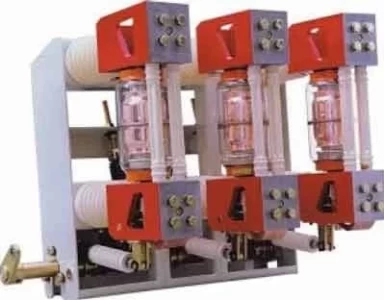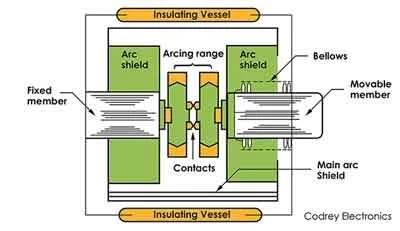Vacuum Integrity and Maintenance in VCBs
Vacuum Circuit Breakers (VCBs) are a critical component in modern electrical protection systems, offering high reliability and low maintenance. However, maintaining the vacuum integrity of these breakers is essential for ensuring their safety and effectiveness. This article discusses the methods for checking vacuum integrity, signs of deterioration, and maintenance schedules to uphold long-term reliability.
The exceptional arc-quenching properties of vacuum circuit breakers (VCBs) are contingent upon maintaining a high-quality vacuum within the sealed interrupters. Loss of vacuum integrity can significantly impact the breaker's ability to safely interrupt fault currents, leading to potentially catastrophic consequences. Diligent monitoring and proactive maintenance are key to ensuring long-term reliability and optimizing the lifespan of VCBs.
Detecting Loss of Vacuum Integrity
- Integrated Monitoring: Many modern VCBs feature built-in vacuum sensors that provide a continuous assessment of vacuum levels. These sensors generate alarms or signals that can be integrated into SCADA systems to alert operators of a deteriorating vacuum.
- Offline Testing: Periodic offline tests serve as a supplementary measure or are used for VCBs without built-in vacuum sensors. Specialized test equipment applies a high voltage across the open contacts of a VCB. Excessive current flow, beyond specific microampere thresholds, indicates a loss of vacuum.
- Visual Indicators: Some VCB designs may incorporate visual pressure indicators or gauges that provide a basic assessment of vacuum conditions. However, these should not be solely relied upon.
Vacuum Integrity in VCBs
Importance of Vacuum Integrity
Vacuum integrity is crucial in VCBs because the vacuum environment inside the interrupter chamber is what allows these devices to operate efficiently and safely. Any compromise in this vacuum can lead to a decline in performance, increased wear and tear, and potentially catastrophic failure during operation.
Methods for Checking Vacuum Integrity
Several methods are employed to assess the vacuum level within a VCB's interrupter chamber:
- Magnetic Field Measurement: Utilizes the magnetic field generated by the interrupter's coil to detect changes in vacuum level.
- Penning Gauge Method: Involves measuring the discharge voltage at which a stable glow discharge occurs, indicative of the vacuum quality.
- Ultrasonic Leakage Detection: Detects high-frequency sounds generated by gas leaks into the vacuum chamber, indicating a loss of vacuum integrity.
Signs of Vacuum Deterioration
Physical Indicators
Visible signs such as corrosion, physical damage to the interrupter chamber, or deposits on the inner walls can indicate vacuum loss. These physical changes can result from external factors or internal failures and require immediate attention.
Electrical Performance Changes
Variations in the VCB’s electrical performance, like increased switching times or higher arc voltages, can suggest a deteriorating vacuum. Consistent monitoring of these parameters is vital to detect early signs of vacuum loss.
Maintenance Schedules for Long-Term Reliability
Regular Inspection and Testing
Routine inspections and testing are fundamental to maintaining VCB reliability. These include:
- Visual Inspections: Regular checks for physical damage or changes in the interrupter.
- Electrical Testing: Periodic tests to assess the breaker's operational performance and detect any signs of vacuum loss.
- Vacuum Level Checks: Specific tests, as mentioned earlier, should be conducted to ascertain the vacuum's integrity directly.
Preventive Maintenance
Adopting a proactive maintenance approach helps in early detection of potential issues, allowing for timely intervention before they escalate. This includes:
- Cleaning and Lubrication: Regular cleaning of the VCB components and appropriate lubrication of moving parts to prevent wear and ensure smooth operation.
- Component Replacement: Scheduled replacement of wear-prone components, like seals or gaskets, to maintain a high level of vacuum integrity.
Record Keeping and Analysis
Maintaining detailed records of maintenance activities, performance data, and test results is crucial. This data aids in trend analysis, helping to predict potential failures and schedule preventive maintenance more effectively.
Conclusion: Ensuring Safety and Effectiveness
Maintaining vacuum integrity in VCBs is essential for their safe and effective operation. Through systematic checking of vacuum levels, recognizing signs of deterioration, and adhering to a rigorous maintenance schedule, the long-term reliability of these crucial components in electrical protection systems can be assured. Adhering to these best practices ensures that VCBs continue to provide the high level of performance and safety expected in modern electrical infrastructures.
Ensuring vacuum integrity is paramount to the safe and reliable operation of VCBs. Implementing proactive monitoring, following structured maintenance practices, and understanding the signs of vacuum degradation can prevent costly failures and minimize downtime. Through these efforts, operators can fully reap the extensive benefits that vacuum circuit breakers offer for modern power distribution systems.




